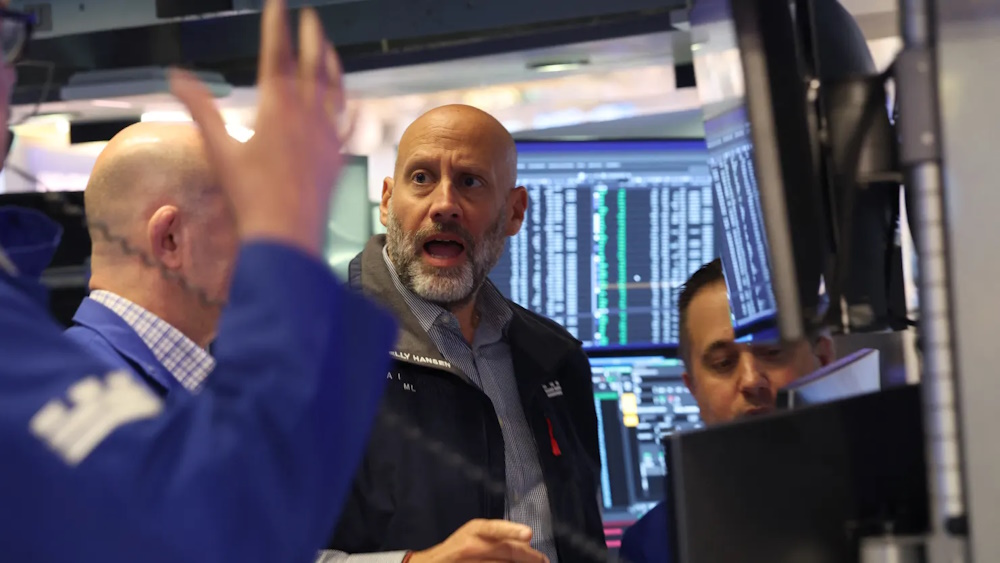
Equities and bitcoin experienced declines amid a prevailing risk-averse mentality across markets. The Dow experienced a decline of 557 points, representing a decrease of 1.18%. The broader S&P 500 experienced a decline of 0.92%. The Nasdaq Composite experienced a decline of 0.84%. Market’s fear gauge experienced a 13% increase. Fear and Greed index has been positioned in a state of “extreme fear,” reaching its lowest point since early April. Equities declined on Monday as investor anxiety heightened in anticipation of two significant events scheduled for this week: Nvidia, the star of the artificial intelligence boom, is set to report earnings on Wednesday. On Thursday, the September jobs report, which has been delayed due to the government shutdown, is scheduled for release. These two events will offer greater understanding of the concerns that are currently prioritized by market participants, as noted by José Torres, senior economist at Interactive Brokers.
This month, technology stocks have faced downward pressure amid ongoing apprehensions regarding high valuations and substantial expenditure strategies employed by major tech firms. The tech-heavy Nasdaq has experienced a decline of nearly 5.5% since reaching a record high in late October. Investors are assessing the stability of the AI trade and contemplating whether the Federal Reserve will halt its interest rate-cutting cycle during the policy meeting in December. Meanwhile, bitcoin experienced a significant decline on Monday, falling below $90,000 for the first time in seven months, thereby negating its gains for the year. The cryptocurrency has declined over 28% in a mere six weeks following its peak above $126,000 in early October. On Monday, the S&P 500 experienced a decline, primarily driven by tech and crypto-related stocks. Coinbase, a crypto exchange, experienced a decline of 7%. On Monday, the S&P 500 and Nasdaq fell beneath their 50-day moving averages, as reported by FactSet. The 50-day moving average serves as a critical support level. “While the long-term uptrend is intact, we believe a corrective pullback/consolidation phase is already underway after the market’s six-month winning streak,” stated Craig Johnson, chief market technician at Piper Sandler, in a note.
Equities are emerging from a week characterized by significant volatility. Tech stocks experienced a significant decline last week, but investors capitalized on the opportunity to purchase at lower prices on Friday. This week, investors are preparing for a potentially significant market event centered around Nvidia’s earnings report. The chipmaker represents approximately 8% of the market capitalization of the S&P 500. Nvidia shares experienced a decline of 1.83% on Monday, contributing to downward pressure on the broader market. “The monthly jobs report would typically take precedence in this week’s economic calendar; however, given the recent struggles in the AI sector, Nvidia’s earnings are once again emerging as a crucial component of the market’s momentum dynamics,” Chris Larkin, managing director at Morgan Stanley’s E-Trade, stated in an email. The recent stock market rally is currently under scrutiny as investors recalibrate their expectations regarding the possibility that the Federal Reserve may halt its interest rate-cutting cycle during the upcoming policy meeting next month. Market participants are assigning a 45% probability to the Federal Reserve implementing rate cuts in December, as per indications. That represents a decline from a 94% probability observed one month prior.
Equities have experienced an upswing driven by positive sentiment regarding potential reductions in Federal Reserve interest rates. Concerns are escalating that the central bank might place a higher emphasis on persistent inflationary pressures. “Data releases starting this week should provide a clearer picture for one of the key risks over the coming weeks — the December Fed meeting,” stated Mohit Kumar. This month, investors have shifted their focus from high-performing technology stocks to sectors that have underperformed and appear comparatively undervalued. “This rotation is both anticipated and beneficial, as it ought to alleviate some of the excess … “and allow this bull market the opportunity to catch its breath before resuming its advance,” stated Sam Stovall.

